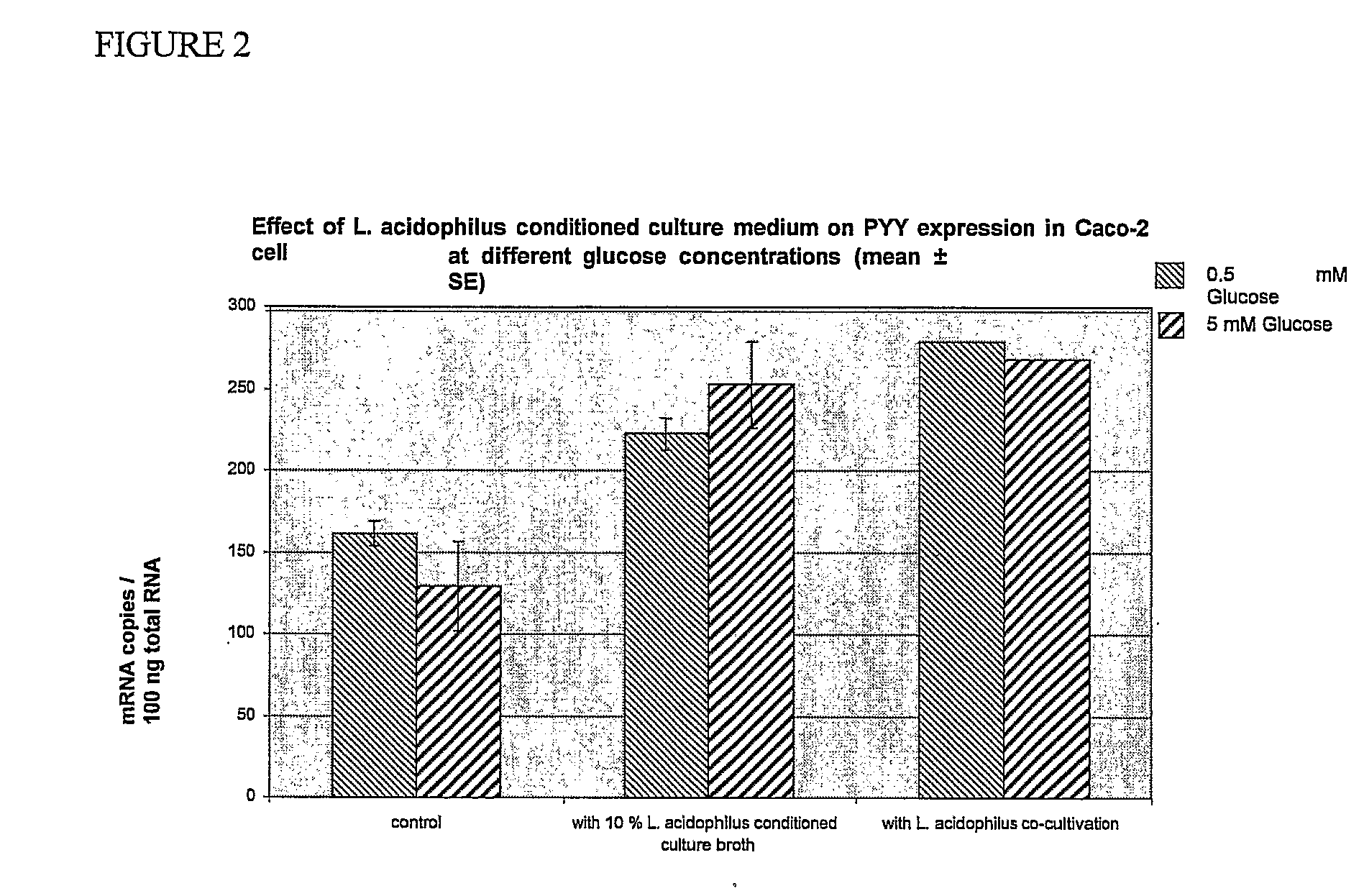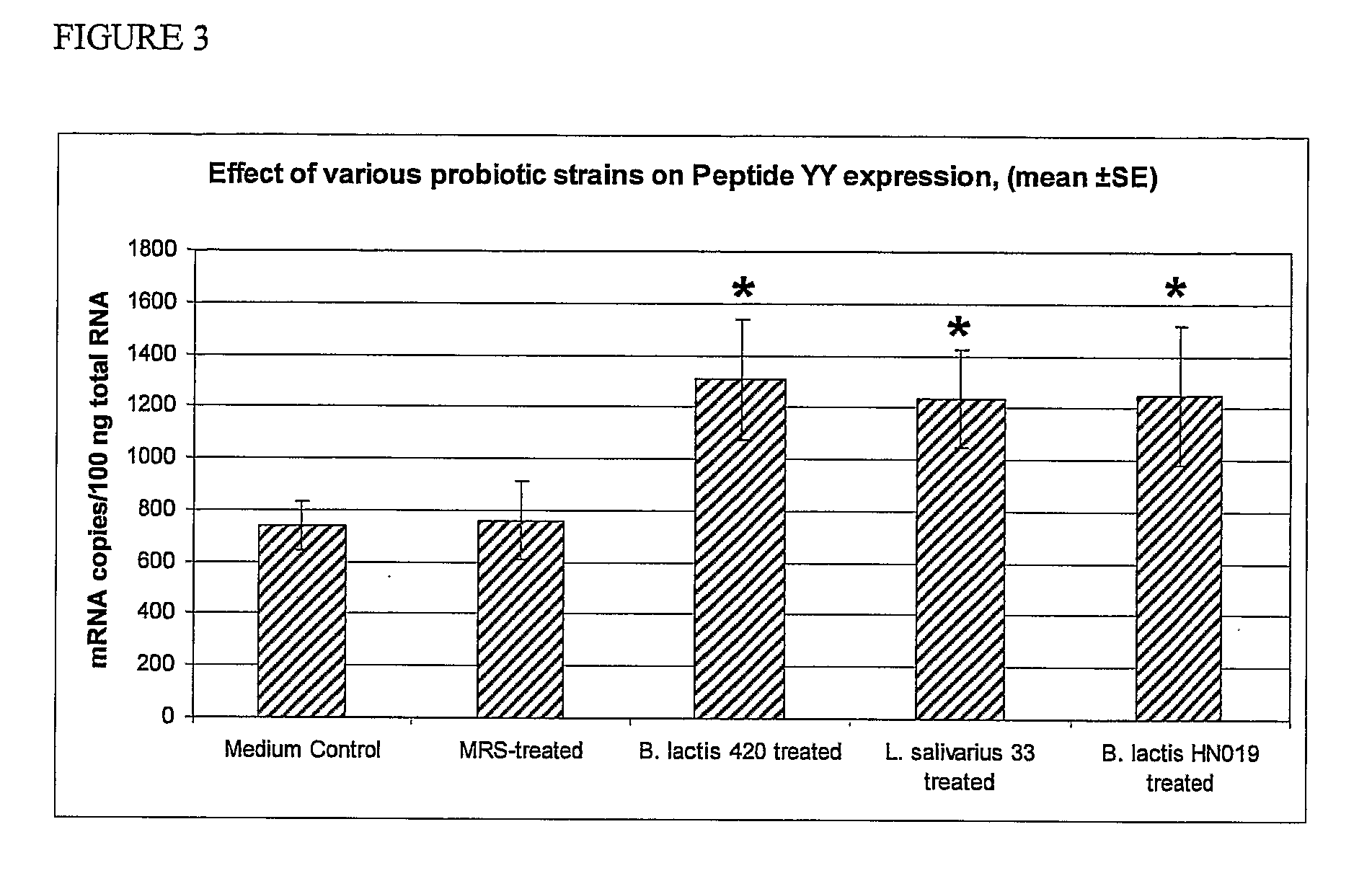Use
a technology of appetite and satiety, which is applied in the field of satiety of appetite, can solve the problems of unpleasant side effects and obesity becoming a major public health problem, and achieve the effects of reducing cancer risk, improving lactose tolerance, and enhancing immune function
- Summary
- Abstract
- Description
- Claims
- Application Information
AI Technical Summary
Benefits of technology
Problems solved by technology
Method used
Image
Examples
example 1
[0285]To Analyze the Gene Expression Pattern of Peptide YY (PYY) in Caco-2 Treated with L. acidophilus.
Method:
[0286]The human colonic carcinoma cell line Caco-2 were cultivated on semiporous cell culture inserts and differentiated according to a 5-day differentiation protocol using differentiation media (DM) composed of Entero-STIM medium supplemented with MITO+ serum extender and containing no antibiotics. The differentiation was monitored using TER-measurements and alkaline phosphatase activity measurement.
[0287]The Lactobacillus acidophilus (strain PTA-4797) bacteria were cultivated on MRS broth supplemented with 1% (weight / vol) glucose until the OD600 reached 0.6-0.7. The L. acidophilus treatment was added into apical side of the cell culture insert and incubated for 24 hours. The RNA was isolated from the cells according to the protocol provided by RNeasy mini kit (Qiagen), and the cDNA synthesized using Superscript III reverse transcriptase (Invitrogen). The gene expression p...
example 2
[0292]In vitro Experiment Mimicking the Meal with Glucose
Experiment with Differentiated Caco-2 Cells. Effect of L. acidophilus Conditioned Culture Broth in Cells Treated with Various Amounts of Glucose
[0293]The Caco-2 were cultivated on semiporous cell culture inserts and differentiated according to a 5-day differentiation protocol using differentiation media (DM) composed of Entero-STIM medium supplemented with MITO+ serum extender and containing no antibiotics. The differentiation was monitored using TER-measurements and alkaline phosphatase activity measurement. On the fourth day of the experiment, the medium was changed with a medium containing no glucose on both sides of the insert and the cells were starved from glucose for 24 h.
[0294]The treatments of the Caco2-cells consisted of control cells, which were treated on the apical side with 0.5 mM, and 5 mM glucose containing medium, and test cells, which were treated on the apical side with 0.5 mM and 5 mM glucose containing med...
example 3
[0301]In vitro Experiments with Other Probiotics
[0302]The Caco-2 were cultivated on semiporous cell culture inserts and differentiated according to a 5-day differentiation protocol using differentiation media (DM) composed of Entero-STIM medium supplemented with MITO+ serum extender and containing no antibiotics. The differentiation was monitored using TER-measurements and alkaline phosphatase activity measurement.
[0303]The treatments of the Caco2-cells consisted of control cells, which were treated with Caco-2 culture medium, and test cells, which were treated with probiotic culture broth in Caco-2 culture medium. In addition, control Caco2-cells with addition of MRS broth diluted in Caco-2 culture medium was included. Cells were incubated for 24 hours at 37° C., 5% CO2,
[0304]The probiotic bacteria were cultivated on MRS broth supplemented with 1% (weight / vol) glucose until the OD600 reached 0.6-0.7. The cells were centrifuged and culture broth was sterile-filtered and used in the ...
PUM
| Property | Measurement | Unit |
|---|---|---|
| Weight | aaaaa | aaaaa |
| Pharmaceutically acceptable | aaaaa | aaaaa |
| Level | aaaaa | aaaaa |
Abstract
Description
Claims
Application Information
 Login to View More
Login to View More - R&D
- Intellectual Property
- Life Sciences
- Materials
- Tech Scout
- Unparalleled Data Quality
- Higher Quality Content
- 60% Fewer Hallucinations
Browse by: Latest US Patents, China's latest patents, Technical Efficacy Thesaurus, Application Domain, Technology Topic, Popular Technical Reports.
© 2025 PatSnap. All rights reserved.Legal|Privacy policy|Modern Slavery Act Transparency Statement|Sitemap|About US| Contact US: help@patsnap.com



